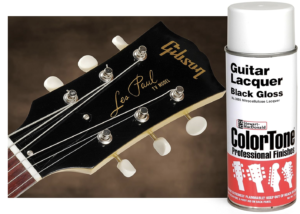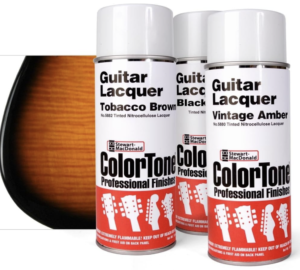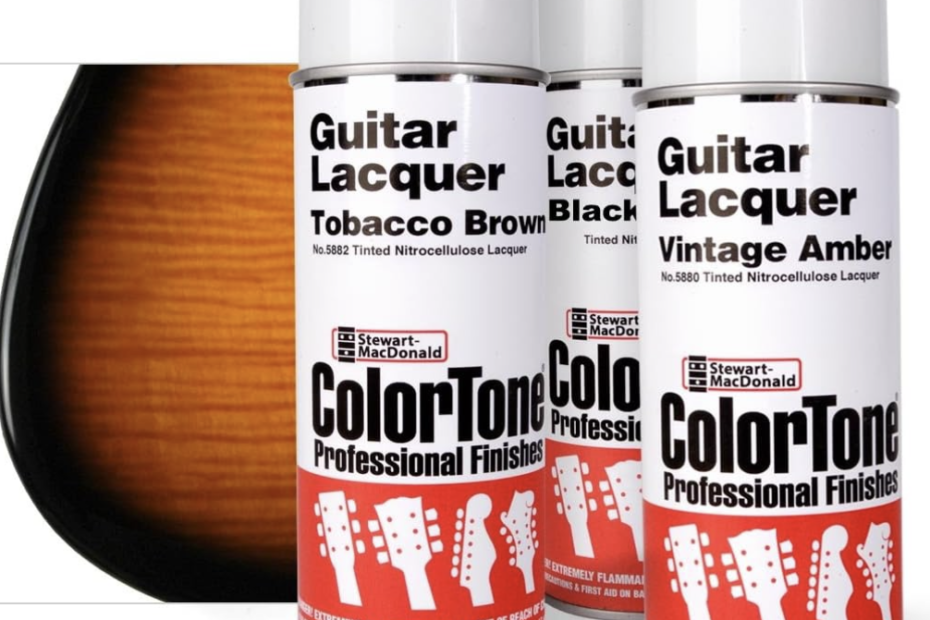Guitars, apart from being musical instruments, are also works of art that inspire emotions through both sound and appearance. One crucial aspect of a guitar’s aesthetics is its paint job. Guitar paint is not just about adding color; it plays a significant role in enhancing the instrument.
The change in it’s overall look, reflecting the player’s personality, also protects the wood from environmental factors.
In this article, we delve into the world of guitar paint, exploring its history, techniques, types, and its impact on the instrument and the musician.
The Historical Roots of Guitar Paint
The tradition of painting guitars dates back to the early 20th century. Initially, guitars were often left in their natural wood finish, showcasing the elegance of the timber.
However, as music and guitar design evolved, players sought ways to personalize their instruments.
The emergence of vibrant colors and custom paint designs became a signature of guitar heroes and iconic bands.
 Techniques of Guitar Painting
Techniques of Guitar Painting
Techniques of guitar painting involve various methods used to apply paint to the guitar’s surface, each offering unique effects and finishes. Here are some common techniques used in guitar painting:
- Spray Painting: Spray painting is the most common and widely used technique in guitar manufacturing and custom guitar painting. It involves using a spray gun or aerosol can to evenly apply paint to the guitar body. Spray painting offers a smooth and consistent coat of color, resulting in a professional and factory-like finish. It allows for quick application and is ideal for mass production.
- Hand-Painted Designs: For custom and one-of-a-kind guitars, hand-painted designs are a popular choice. Skilled artists use brushes and fine tools to create intricate artwork directly on the guitar body. This technique allows for complete creative freedom, enabling musicians to add personalized patterns, graphics, or illustrations to their instruments. Hand-painted designs can range from simple logos and symbols to elaborate murals or abstract art.
- Airbrushing: Airbrushing is a technique that employs an airbrush tool to apply paint in fine and controlled sprays. It allows for precise and detailed designs, making it ideal for creating gradients, fades, and intricate patterns. Airbrushing is commonly used to create custom finishes, such as sunbursts, fades, and flames. Skilled airbrush artists can achieve stunning visual effects and create a unique and eye-catching appearance for the guitar.
- Stenciling: Stenciling is a method where pre-cut stencils are used to apply specific designs or patterns onto the guitar body. The stencils are placed on the guitar surface, and paint is sprayed or brushed over them. This technique allows for consistent replication of designs and is commonly used for logos, brand names, or simple shapes.
- Aging and Relic Finishing: Aging or relic finishing is a specialized technique used to give a guitar an aged, vintage appearance. The process involves carefully distressing the paint job to simulate wear and tear over time. Commonly, the edges of the guitar body and hardware are gently sanded, revealing the wood underneath and creating a worn, vintage look. This technique is popular among players who prefer the character and charm of a vintage instrument.
- Dip Painting or Hydro Dipping: Hydro dipping, also known as water transfer printing, is a unique technique that involves placing a specialized film with the desired pattern on the surface of a water tank. The guitar body is then dipped into the water, and the film adheres to the surface. The excess film is removed, leaving a seamless and detailed pattern on the guitar body. Hydro dipping allows for complex designs and patterns that are challenging to achieve using other methods.
Also Read:
Selecting the Best Guitar Pick
Mexican Guitar: The Enchanting Sound of the Guitarron
Guitar Anatomy: Understanding Guitar Components
Guitar Wireless System: Unleashing Freedom
The 8-String Guitar: Expanding Your Possibilities
How to Learn Guitar Faster: 3 Easy Secrets
 Types of Guitar Paints
Types of Guitar Paints
Types of guitar paints can vary based on their composition, finish, and application methods. The choice of paint can significantly affect the appearance, durability, and playability of the guitar. Here are some common types of guitar paints:
- Nitrocellulose Lacquer: Nitrocellulose lacquer is one of the most traditional and widely used finishes in guitar manufacturing. It has been favored by many guitar makers for its excellent tonal qualities and vintage aesthetics. Nitrocellulose lacquer is typically sprayed on the guitar body in thin layers, allowing the wood to resonate more freely and produce a rich, warm tone. This finish ages beautifully over time and develops a distinctive patina known as “checking.”
- Polyurethane: Polyurethane, often referred to as poly, is a popular choice for modern guitars and mass-produced instruments. It provides a thick and durable coating that offers excellent protection against scratches and dents. Polyurethane finishes can be glossy or satin, and they are less prone to wear and fading compared to nitrocellulose lacquer. However, some players find that polyurethane can be less resonant, impacting the guitar’s overall tone.
- Acrylic: Acrylic paint is water-based and often used for custom guitar painting due to its versatility and ease of use. It can be applied with brushes or spray guns and is available in a wide range of colors. Acrylic paints dry relatively quickly, making them suitable for artists who want to experiment with different designs and effects.
- Oil-Based Paint: Oil-based paint offers a smooth and glossy finish, providing excellent depth and color richness. It is often used for hand-painted custom designs and artwork on guitars. Oil-based paint takes longer to dry compared to other types of paint, but it allows artists to blend and mix colors more effectively, resulting in stunning and detailed artwork.
- Water-Based Polyurethane: Water-based polyurethane is an eco-friendly alternative to traditional polyurethane finishes. It provides similar durability and protection while emitting fewer harmful fumes during application. Water-based polyurethane finishes can be clear or tinted, giving guitarists the option to enhance the wood’s natural color or add a touch of color to the instrument.
- Metallic Paint: Metallic paints contain small metallic particles that create a shimmering effect on the guitar’s surface. They are often used to achieve eye-catching finishes, such as metal flakes, sparkles, or pearlescent colors. Metallic paint can add a unique and modern touch to the guitar’s appearance.
- Powder Coating: Powder coating is a durable and long-lasting finish used in some guitar models. It involves applying dry powder to the guitar body and then curing it using heat. Powder coating offers excellent protection against scratches and wear, making it a popular choice for heavy-duty guitars.
 Impact of Guitar Paint on Sound
Impact of Guitar Paint on Sound
While the primary function of guitar paint is aesthetic, it can also influence the instrument’s tone to a certain extent. Nitrocellulose lacquer, known for its thin application, allows the wood to breathe, potentially affecting the guitar’s resonance. On the other hand, thick polyurethane coatings may dampen vibrations slightly, creating a more controlled and consistent sound.
- Expressing Individuality: Guitar paint offers musicians a canvas to express their individuality and creativity. Custom paint jobs allow players to stand out on stage, creating a strong visual identity that complements their music.
- Guitar Paint Care and Maintenance: To maintain the integrity of the paint job, it is crucial to take proper care of the guitar. Regular cleaning with a soft, non-abrasive cloth, avoiding extreme temperatures, and storing the instrument in a controlled environment will prolong the paint’s life and preserve the guitar’s appearance.
Conclusion
Guitar paint is much more than a cosmetic addition; it’s an essential aspect of guitar design that reflects the instrument’s personality and the musician’s creativity.
From classic nitrocellulose lacquer to modern water-based paints, each type of paint offers distinct characteristics that can impact the guitar’s sound and aesthetics.
Whether you prefer a vintage look or a custom design, the world of guitar paint provides endless possibilities for musicians to create their musical masterpieces.
